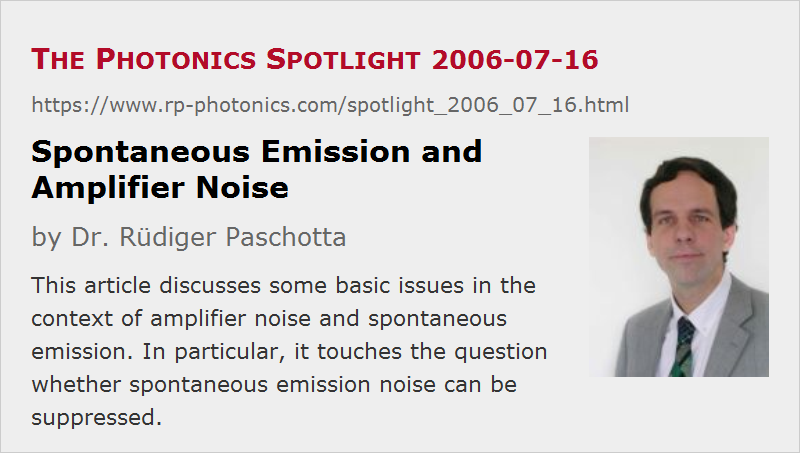Spontaneous Emission and Amplifier Noise
Posted on 2006-07-16 as a part of the Photonics Spotlight (available as e-mail newsletter!)
Permanent link: https://www.rp-photonics.com/spotlight_2006_07_16.html
Author: Dr. Rüdiger Paschotta, RP Photonics Consulting GmbH
Abstract: This article discusses some basic issues in the context of amplifier noise and spontaneous emission. In particular, it touches the question whether spontaneous emission noise can be suppressed.

It is known that laser amplifiers exhibit some level of excess noise, which is often explained as the effect of spontaneous emission. Also, it has been reported that under some circumstances it is possible to largely suppress spontaneous emission. This has e.g. lead to thresholdless lasers. So shouldn't it be possible to somehow suppress a laser amplifier's excess noise?
Spontaneous emission generates radiation in all modes with suitable frequencies. In an amplifier, only a very small fraction of the power of spontaneous emission usually goes into the amplified mode, but this is what causes the excess noise. The emission going into all the other modes constitutes nearly all of the power loss, but as it can be separated from the amplified light, it is not relevant in the context of amplifier noise.
Now one can in principle surround the amplifying medium by a structure (e.g. a microcavity) which modifies the mode distribution so that there are fewer modes with frequencies which are suitable for the spontaneous emission. In this way one can reduce the power loss, but one cannot avoid emission into the amplified mode, and thus not reduce the amplifier noise.
There are even fundamental quantum-mechanical reasons why the excess noise of any phase-insensitive optical amplifier – whatever physical principle it may be based on – can never be lower than that of an ideal four-level laser amplifier, or of a degenerate optical parametric amplifier. (Quasi-three-level amplifiers don't even reach that limit.) So we see that any type of amplifier not exhibiting spontaneous emission must have some other noise influences which generate at least the same level of noise.
The only way around this limitation is to use a phase-sensitive amplifier, such as a degenerate parametric amplifier, which can in principle operate without any excess noise.
This article is a posting of the Photonics Spotlight, authored by Dr. Rüdiger Paschotta. You may link to this page and cite it, because its location is permanent. See also the RP Photonics Encyclopedia.
Note that you can also receive the articles in the form of a newsletter or with an RSS feed.
Questions and Comments from Users
Here you can submit questions and comments. As far as they get accepted by the author, they will appear above this paragraph together with the author’s answer. The author will decide on acceptance based on certain criteria. Essentially, the issue must be of sufficiently broad interest.
Please do not enter personal data here; we would otherwise delete it soon. (See also our privacy declaration.) If you wish to receive personal feedback or consultancy from the author, please contact him e.g. via e-mail.
By submitting the information, you give your consent to the potential publication of your inputs on our website according to our rules. (If you later retract your consent, we will delete those inputs.) As your inputs are first reviewed by the author, they may be published with some delay.
 |



If you like this page, please share the link with your friends and colleagues, e.g. via social media:
These sharing buttons are implemented in a privacy-friendly way!